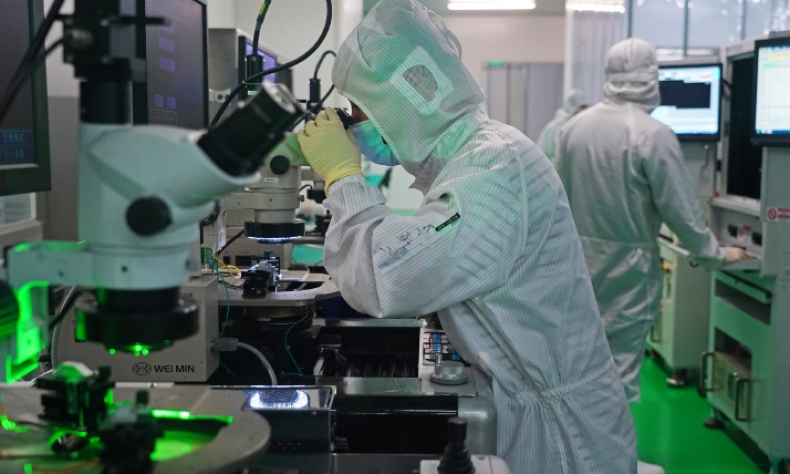Lithography Literacy

The country must remain levelheaded and patient, encouraging and supporting domestic enterprises in R&D, personnel training and international cooperation.
The guidance catalog for major technical equipment issued by the Ministry of Industry and Information Technology on September 9 has attracted widespread attention. Among the listed items is a deep ultraviolet (DUV) lithography machine, which operates at a wavelength of 193 nanometers (nm), with a resolution below 65 nm and an overlay accuracy under 8 nm. Its inclusion in the catalog, which aims to promote the use of listed equipment, signifies that China has made breakthroughs in high-end chip manufacturing.
Lithography machines are among the most critical equipment in the production of semiconductors and integrated circuits, as the lithography process determines how small the transistors on a chip can be. The DUV lithography machine represents cutting-edge technology in global semiconductor manufacturing.
China’s achievements in the research and development (R&D) of high-end lithography machines are of considerable significance. These advancements reflect a growing self-reliance in hi-tech fields, reducing its dependence on external technologies for lithography machines, and enhancing its capacity for domestic innovation.
The domestically developed lithography machines are expected to play a big role in ensuring the stability and security of China’s semiconductor supply chain, mitigating risks associated with external supply disruptions. Furthermore, these machines are anticipated to reduce chip manufacturing costs, improve production efficiency and lift the competitiveness of Chinese products in the global semiconductor market.
In 2018, the United States initiated a trade war against China as part of its strategy to contain China’s development. This conflict, originally centered on the economy, soon expanded to include education, culture, science and technology.
The U.S. has also resorted to “coercive diplomacy,” leveraging its national power and technological dominance. This includes not only prohibiting U.S. companies from exporting chips to China but also pressuring lithography-producing countries like the Netherlands to ban their exports to China. As a result, China has accelerated its efforts toward achieving self-reliance in science and technology.
The Chinese Government has provided substantial support to the semiconductor industry. After years of R&D, as well as high investment, China’s lithography technology has finally made initial breakthroughs. These advancements have also led to the integration of several cutting-edge technologies, further propelling the development of related fields. For example, Chinese tech titan Huawei’s Hisilicon Kirin chipsets had previously achieved an advanced level in design, but their manufacturing was hindered by the lack of high-end lithography machines. The recent innovations in domestic high-end lithography technology will elevate the development of China-made chips.
Although China has made progress in developing lithography machines, they still lag behind the most advanced international technology. For instance, the extreme ultraviolet lithography machine, developed exclusively by Dutch semiconductor equipment manufacturer ASML, uses light with a wavelength of only 13.5 nm—shorter wavelengths mean higher resolution. Therefore, despite Chinese achievements in domestic lithography technology, it is important to remain realistic and avoid blind optimism.
However, this does not mean we should be pessimistic and believe that after years of effort, it is impossible to reach the world’s leading level. Recognizing the current tech gap is the first step toward increasing self-reliance in innovation and catching up. It is promising to note that the initial breakthroughs in lithography technology lay a solid foundation for future technological progress and industrial upgrades.
Through the use of domestically developed lithography equipment, China can accumulate valuable technological experience, nurture talent and gradually move toward more advanced technologies. China’s semiconductor industry is now at a decisive stage of rapid development, packing enormous market potential, supportive policies and growing R&D capabilities, despite challenges.
The country must remain levelheaded and patient, encouraging and supporting domestic enterprises in R&D, personnel training and international cooperation. This approach will help narrow the gap with global leaders and ultimately achieve self-sufficiency in the chip industry.
 Facebook
Facebook
 Twitter
Twitter
 Linkedin
Linkedin
 Google +
Google +










